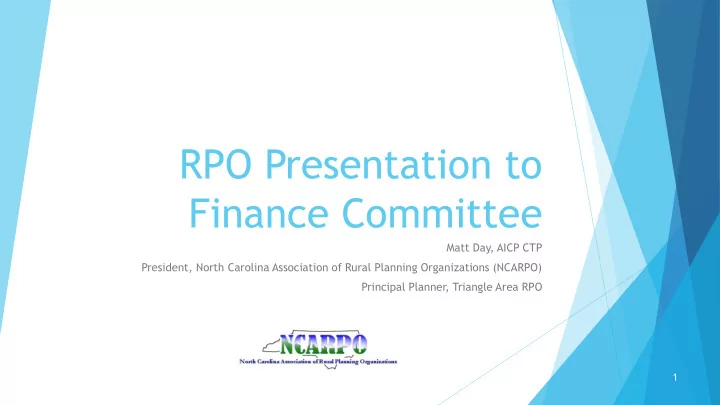

RPO Presentation to Finance Committee Matt Day, AICP CTP President, North Carolina Association of Rural Planning Organizations (NCARPO) Principal Planner, Triangle Area RPO 1
About Rural Planning Organizations (RPOs) There are 18 RPOs in North Carolina We serve all parts of the state that are not part of a Metropolitan Planning Organization (MPO) Each RPO has a Technical Committee made up of local staff and a Transportation Advisory Committee made up of elected officials RPOs serve a mixture of rural and small urban areas 2
About Rural Planning Organizations (RPOs) Primary RPO Activities Include: Working cooperatively with NCDOT and local governments to develop Comprehensive Transportation Plans (CTPs) Submitting and prioritizing projects through the Strategic Transportation Investments (STI) prioritization process Participating in and representing local/regional interests in the project development process Participating in other transportation plans/activities in the region (e.g local bicycle/pedestrian plans, county transit agencies, etc.) Sharing information with our members Serving as a technical resource for our members 3
Major Transportation Challenges Facing Rural North Carolina Competition for limited funding available in STI Rural projects generally have a harder time competing well in STI due to lower congestion, lower volume, etc. Difficulty of competition varies widely by Division/Region RPOs and NCDOT are working together to ensure that we submit the most competitive projects possible in rural areas 4
Major Transportation Challenges Facing Rural North Carolina Major statewide corridors connecting urban areas, ports, and job centers often require improvements in rural areas Aid in connectivity from rural areas to existing job centers Aid in attracting/retaining jobs and investment in rural areas Important to get regional buy-in for improvement of these corridors and a plan for implementation (including an approach for funding through STI) Opportunity for working together 5
Major Transportation Challenges Facing Rural North Carolina Identifying ways to fund & build smaller improvements such as: Modernization of substandard roads Small projects of local importance Economic development projects Bicycle, Pedestrian, and Transit needs Some of these may be possible within existing STI framework, but some may require creative solutions 6
Societal Changes/Trends that Impact Rural Transportation Planning Demographic Changes Increasing senior population Retirement/second home destinations Loss of population in some areas Encroaching suburbanization in some areas Increasing Hispanic/Latino populations Affects issues such as transit & bike/ped need, tradeoffs between needs and wants, Environmental Justice/Title VI 7
Societal Changes/Trends that Impact Rural Transportation Planning Demographic Changes Shift away from manufacturing economy in many, but not all, areas Economic Changes Rise of distribution & logistics related jobs Agriculture a major industry, particularly in east Long-distance commuting to urban job centers Affects highway connectivity and access needs, transit connectivity, port/freight terminal accessibility 8
Societal Changes/Trends that Impact Rural Transportation Planning Demographic Changes Response to natural disasters such as floods and landslides, and lack of available alternatives Economic Changes Need for raising/retrofitting facilities that do not fit neatly in typical STI process Resiliency to Emergency Situations Affects maintenance and emergency planning needs, modernization projects, and need for redundant/alternative routes/services 9
Societal Changes/Trends that Impact Rural Transportation Planning Vehicle technology – electric vehicles, connected and autonomous Demographic Changes vehicles Requires broadband infrastructure Economic Changes investments, EV charging infrastructure; uncertainty about impact on trip-making/congestion Resiliency to Emergency Situations Teleworking Requires broadband infrastructure investments; potential for major Technology Changes impacts on commute travel/accessibility of jobs for rural residents Mobility services – ridesharing apps, scooters, bikeshare, autonomous transit, etc. More likely in urban areas first, but monitoring options for rural use 10
Urban/Rural Divide Collaboration Cooperation on planning and prioritizing projects that connect communities/corridors Coordination on STI process Coordinated planning (joint studies, corridor commissions, etc.) Commitment to work together collaboratively on statewide initiatives Prioritization work group 11
Questions? Matt Day, AICP CTP Principal Planner, Triangle Area RPO (919) 558-9397 | mday@tjcog.org 12
Recommend
More recommend